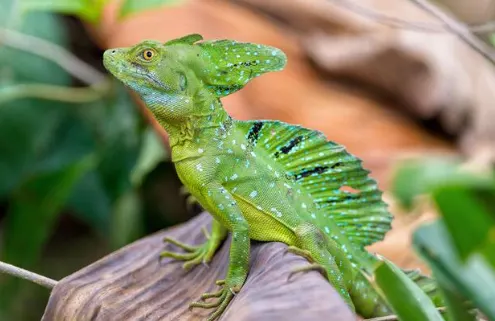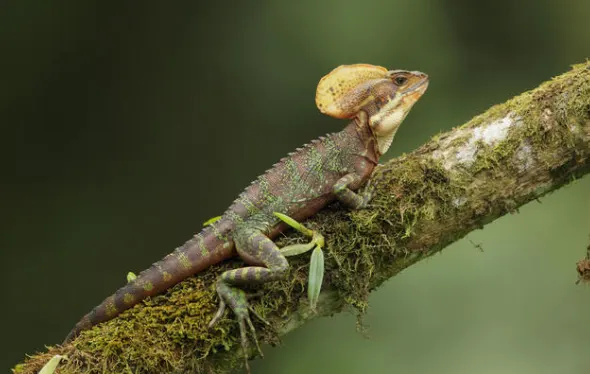The basilisk lizard, commonly referred to as the “Jesus Lizard” due to its remarkable ability to run on water, is one of the most fascinating creatures in the animal kingdom. Found primarily in Central and South America, this lizard captivates with its vibrant colors, unique behaviors, and incredible adaptations. Let’s dive deeper into the world of the basilisk lizard and explore its many intriguing aspects.
Table of Contents
Scientific Classification
- Kingdom: Animalia
- Phylum: Chordata
- Class: Reptilia
- Order: Squamata
- Family: Corytophanidae
- Genus: Basiliscus
Conservation Status
- Status: Least Concern

Habitat and Distribution
Basilisk lizards thrive in tropical rainforests near rivers and streams in Central and South America, particularly in countries like Costa Rica, Honduras, Nicaragua, and Panama. These semi-arboreal and semi-aquatic lizards prefer elevations from sea level up to 2,542 feet.
Physical Characteristics
Basilisk lizards are known for their vibrant and varied colors, which include shades of brown, yellow, red, blue, black, and green. These colors not only make them visually stunning but also help in identifying different species. The tail of a basilisk lizard makes up about 75% of its total length, which averages around 2.5 feet.
Behavior and Lifestyle
Despite their beauty, basilisk lizards are not friendly creatures. They are highly skittish and tend to avoid human interaction. They are solitary animals, spending their days foraging for
Unique Adaptations
One of the most remarkable features of the basilisk lizard is its ability to run on water. This adaptation is due to the fringes on their feet, which create air pockets, allowing them to stay afloat as they sprint across the water’s surface. This ability helps them escape predators and chase prey.
Diet
Basilisk lizards are omnivores, with their diet consisting mainly of insects, spiders, small mammals, snails, and other small reptiles. They also consume a significant amount of plant matter, which makes up about 20-30% of their diet.
Reproduction and Life Cycle
Females lay up to 20 eggs per clutch, with up to four clutches per year. The eggs are laid in trenches and left unattended. Hatchlings emerge after 8-10 weeks and are immediately capable of running, swimming, and climbing. Basilisk lizards reach sexual maturity between 10-15 months and can live up to 7 years in captivity.
Predators and Threats
The primary predators of basilisk lizards include large birds, snakes, fish, and other reptiles. The quetzal, a bird, is particularly known for preying on these lizards. Human activities, such as pollution and habitat destruction, also pose significant threats to their population.
Fun Facts
- Basilisk lizards can run up to 15 mph.
- They are often referred to as “Jesus Lizards” because of their ability to run on water.
- Their feet have unique adaptations like hinges and hollow bones to help them stay afloat on water.
Common Questions About Basilisk Lizards
Q: What is a basilisk lizard?
A: The basilisk lizard is a reptile found primarily in Central and South America. It is known for its vibrant colors and the unique ability to run on water.
Q: Are basilisk lizards good pets?
A: While basilisk lizards are beautiful, they are not the friendliest pets. They are skittish and can be easily angered, making them less suitable for handling.
Q: Is the basilisk lizard poisonous?
A: No, basilisk lizards are not poisonous.
Q: What do basilisk lizards eat?
A: Their diet mainly consists of insects, but they also eat spiders, small mammals, snails, and plant matter.
Q: Why are basilisk lizards called basilisks?
A: The name “basilisk” comes from the Greek word “basilískos,” meaning “little king.” It also refers to the mythical creature known for its deadly gaze.
Q: How can basilisk lizards run on water?
A: The fringes on their feet create air pockets, allowing them to run quickly across the water’s surface without sinking.

Q: How long can a basilisk lizard run on water?
A: A basilisk lizard can run across 33 to 66 feet of water.
Q: Can a basilisk lizard regrow its tail?
A: No, unlike some other lizards, basilisk lizards cannot regrow their tails.
Q: How big of a tank does a basilisk lizard need?
A: A large
Q: How long does a basilisk lizard live?
A: In captivity, basilisk lizards typically live up to 7 years. Their lifespan in the wild is often shorter due to predators.
Q: Can you buy a basilisk lizard?
A: Yes, they can be purchased for $3 to $20, but they require specific care and housing.
The basilisk lizard is a remarkable reptile with unique adaptations and striking features. Its ability to run on water and its vibrant colors make it a captivating subject for enthusiasts and researchers alike. While they can be kept as pets, their skittish nature and specific care requirements mean they are best admired in their natural habitat. With ongoing threats from habitat destruction and pollution, it is crucial to continue efforts to preserve the natural environments of these fascinating creatures.
- Enchi Ball Python: A Unique and Stunning Morph of Python regius - March 27, 2025
- Emerald Tree Monitor: The Enigmatic Green Guardian of the Rainforest - March 26, 2025
- The Egyptian Cobra (Naja haje): A Fascinating Serpent - March 25, 2025
